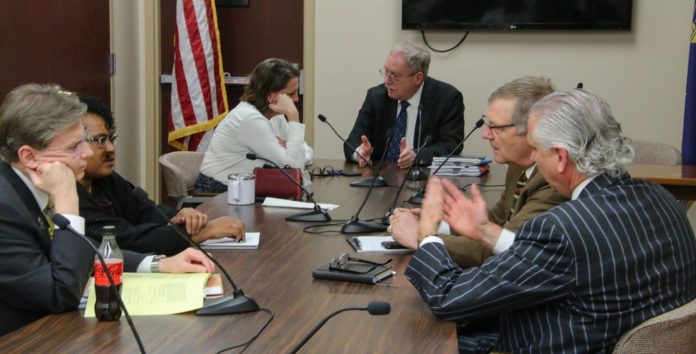Explainer: Conference Committees And How They Can Save Dead Legislation
- By Taylor Wooten, TheStatehouseFile.com
- Â
INDIANAPOLIS—During the final weeks of the Indiana General Assembly’s 2022 legislative session, several bills were transformed through conference committees.
What are those? The legislature’s website offers a succinct explanation:
“If the conferees reach a compromise, the chambers vote whether to accept the conference committee’s decision. Generally, conference committees are comprised of two legislators from each chamber appointed by the President Pro Tempore of the Senate and the Speaker of the House. If the committee is unable to reach a compromise, the bill dies.â€
Andy Downs, director of the Mike Downs Center for Indiana Politics at Purdue University Fort Wayne, called conference committees “a magical place†because of the ways they change bills, often behind closed doors.
“When you look at the grand scheme of all of the bills that go to the conference committee, you always have to remember, what’s the bigger picture?†Downs said. “What’s the negotiation that’s going on?â€
Stripping-and-inserting bills
This session, one example of this was the strip-and-insert that was done onSenate Bill 209. In a conference committee, legislators took SB 209, which was initially a drug bill, and replaced it with permitless carry legislation.
Democrats disagreed with this decision. In a video released by the Indiana House Democrats, Rep. Ragen Hatcher, D-Gary, discussed how it happened. The House Democrats also issued a press release on the topic.
“Today, the supermajority used the conference committee process to resurrect their radical proposal to eliminate handgun permits in Indiana,†Hatcher said. “The Democratic members of this committee were given mere minutes to look over the committee report.â€
Senate Minority Leader Sen. Greg Taylor, D-Indianapolis, disagreed with the conference committee decision to suddenly revive the dead bill and held time for testimony following the committee meeting. That’s when a representative of the Indiana State Police spoke out against the bill.
The gun licensing language ended up in House Enrolled Act 1296, which was signed into law by Gov. Eric Holcomb Monday.
Often, similar strip-and-insert procedures are denied if the changes aren’t germane, or relevant, to the initial bill, according to Downs. But the legislature wanted to push through the permitless carry legislation, and it’s become a “nationalized†issue, he said, meaning Indiana appeared to be falling behind compared to states that passed similar legislation.
“They wanted to make sure they got it done,†Downs said. “They’ve been trying to do it for years, and given the supermajority, I think a lot of people would wonder why they hadn’t.â€
Swapping committee members
The rules a particular institution operates under matter significantly, Downs said.
In Indiana, each chamber has two conference committee members, along with a few additional members as non-voting advisers. In other states, it’s more common that there are three or more voting members.
In both chambers in Indiana, a unanimous vote and signatures of all conferees are required. This is unique since many states just require a majority vote and the majority of the conferees to sign the report.
Conferees are sent back to their caucuses following a conference committee meeting to decide if they wish to sign off on a conference committee report. Because all four members must sign the report in order for it to move to the full chamber, legislative leaders exercise the power to replace conference committee members unwilling to pass reports determined important to the majority.
This past session, several Democratic conference committee members were swapped out for Republican ones under the Republican supermajority. On the final day of the session, Rep. Terri Austin, D-Anderson, and Sen. Michael Griffin, D-Hammond, were removed as conferees on the gun legislation, HB 1296.
“The supermajority, no matter what state you’re in, creates an interesting set of circumstances. Because although the bodies have the rules by which they operate, sometimes they can suspend rules or change rules, but it may take a supermajority vote to do it,†Downs said. “And if you’re in the supermajority with one party, it becomes a whole lot easier to make those sorts of changes.â€
Indiana House conferees are chosen by the House speaker, while Senate conferees are appointed by the Senate president pro tem—Rep. Todd Huston, R-Fishers, and Sen. Rodric Bray, R-Martinsville. Five states allow the minority leader to appoint or have input on conferees, but Indiana is not one of them.
Following adoption by the committee of a committee report, a majority is needed to adopt the legislation on the floor of both chambers.





